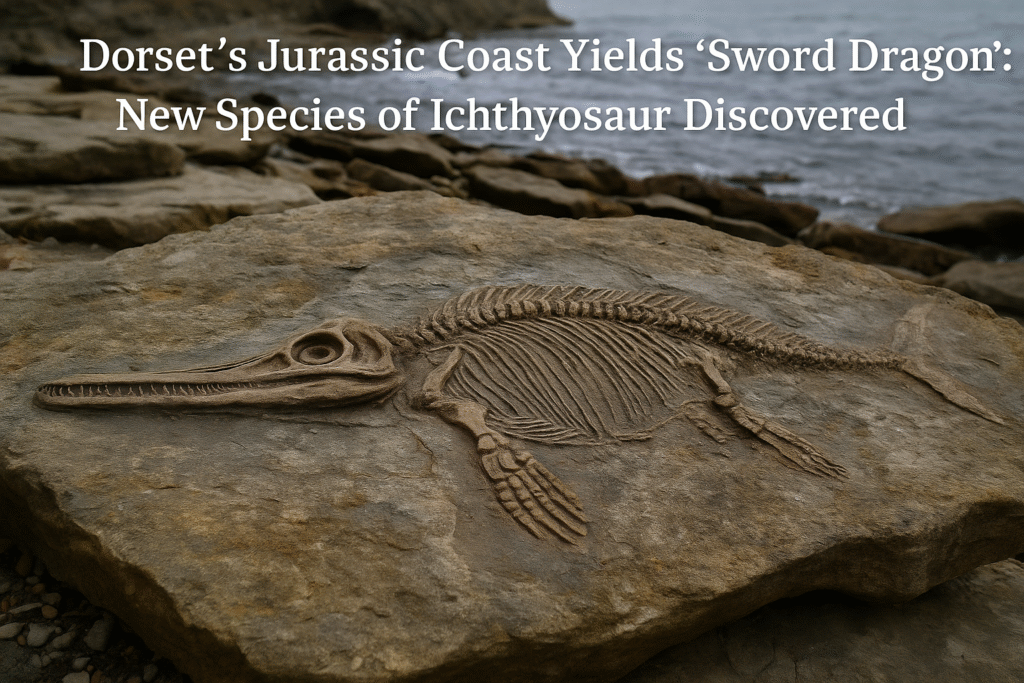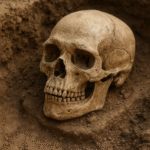By Harshit | 10 October 2025 | Dorset, UK | 10:15 AM
A near-complete fossil skeleton discovered along Dorset’s Jurassic Coast has been identified as a new species of ichthyosaur, a marine reptile that dominated the oceans during the Mesozoic era. The newly described species, Xiphodracon goldencapensis, nicknamed the “sword dragon of Dorset,” is the only known specimen of its kind, providing significant insight into the diversity and evolution of Jurassic marine reptiles.
Discovery and Identification
The specimen was first uncovered in 2001 by fossil hunter Chris Moore at Golden Cap, Dorset. It was subsequently acquired by the Royal Ontario Museum in Canada, where it remained for over 15 years before a team of paleontologists conducted a full analysis. The results, published recently, confirm that the skeleton represents a previously unknown species of ichthyosaur.
Dr. Dean Lomax, an ichthyosaur specialist and co-author of the study, explained the nomenclature: “Xiphodracon translates to sword-like dragon, referring to both the elongated, pointed snout and the historical term ‘sea dragons’ used for ichthyosaurs over the past 200 years.”
The fossil measures approximately three meters in length and exhibits several unique anatomical features, including a prong-like bone near the nostril, an enormous eye socket, and a long, sword-shaped snout adapted for preying on fish and squid.
Clues About Life and Death
Detailed examination of the skeleton revealed evidence of injury and possible disease. According to Dr. Erin Maxwell of the State Museum of Natural History Stuttgart, the limb bones and teeth show malformations that likely developed during the animal’s lifetime. Moreover, the skull bears marks consistent with a bite from a larger ichthyosaur, suggesting predation may have been the cause of death.
“Life in Jurassic oceans was perilous,” Dr. Maxwell noted. “This individual provides direct evidence of predator-prey interactions among ichthyosaurs and highlights the ecological pressures these marine reptiles faced.”
Evolutionary and Paleontological Significance
Ichthyosaurs are marine reptiles, distinct from dinosaurs, and fossils from the Middle Jurassic, around 185 million years ago, are exceptionally rare. Dr. Lomax emphasized that Xiphodracon goldencapensis represents the most complete individual from this period, helping to fill a critical gap in ichthyosaur evolutionary history. The discovery provides new data on anatomical variation, feeding adaptations, and life history traits within early ichthyosaur lineages.
This specimen also contributes to the broader fossil record of Dorset’s Jurassic Coast, a site of historical importance where pioneering paleontologist Mary Anning discovered numerous ichthyosaur fossils in the early 19th century. Xiphodracon adds to a growing list of species identified from this region, demonstrating the continued scientific value of Dorset’s cliffs and coastline.
Unique Features and Ecological Insights
Xiphodracon exhibits several distinctive features not seen in other ichthyosaurs. The sword-like snout suggests specialization for rapid prey capture, while the massive eye socket indicates acute vision in low-light or deep-water environments. These adaptations, combined with evidence of skeletal injuries and predation, provide a rare glimpse into the ecological dynamics of Jurassic marine ecosystems.
The presence of malformed bones and teeth also hints at the resilience of these reptiles, as individuals could survive injuries and disease long enough to leave fossil evidence. Such details offer paleontologists valuable information on growth, survival, and interspecies interactions in prehistoric oceans.
Legacy of the Discovery
Chris Moore, the fossil hunter who discovered the “sword dragon,” has unearthed approximately 15 ichthyosaur specimens during his career, with several representing previously unknown species. Moore reflected on the significance of Xiphodracon, stating, “This discovery is particularly special due to its completeness and the insights it provides into ichthyosaur evolution and ecology.”
The identification of Xiphodracon goldencapensis underscores the scientific importance of Dorset’s Jurassic Coast as a repository of ancient marine life. The specimen enhances understanding of ichthyosaur anatomy, evolution, and behavior, while offering a vivid example of predator-prey relationships in the Mesozoic seas.







